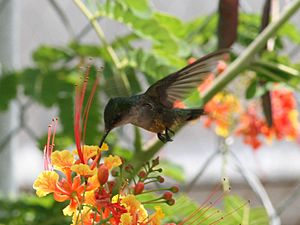Puerto Rican emerald facts for kids
Quick facts for kids Puerto Rican emerald |
|
|---|---|
 |
|
| Conservation status | |
| Scientific classification | |
| Genus: |
Riccordia
|
| Species: |
maugaeus
|
The Puerto Rican emerald (Riccordia maugeaus), or zumbadorcito de Puerto Rico in Spanish, is an endemic hummingbird found only in the archipelago of Puerto Rico.
The species displays sexual dimorphism with males and females differing in coloration. The male has iridescent green feathers on its body and a black tail while the female has a white breast and white out tail feathers. They measure 9-10 cm and weigh about 3 grams. The species is found mainly in mountainous regions of Puerto Rico but also occurs along the southwest coast of the main island. Puerto Rican emeralds are highly territorial, often defending territories with intense aerial pursuits.
Puerto Rican emeralds use their long pointed bills and long tubular tongues to probe for insects, spiders and nectar, being especially attracted to red flowers. They can breed year-round but breeding is concentrated before the wet season starts from February to May. The female lays two tiny white eggs (measuring 8–13 mm) in a nest cup made of grasses and twigs. The male plays no part in the nesting process.
This species was formerly placed in the genus Chlorostilbon. A molecular phylogenetic study published in 2014 found that the genus Chlorostilbon was polyphyletic. In the revised classification to create monophyletic genera the Puerto Rican emerald was moved to the resurrected genus Riccordia.
See also
 In Spanish: Zumbadorcito de Puerto Rico para niños
In Spanish: Zumbadorcito de Puerto Rico para niños


